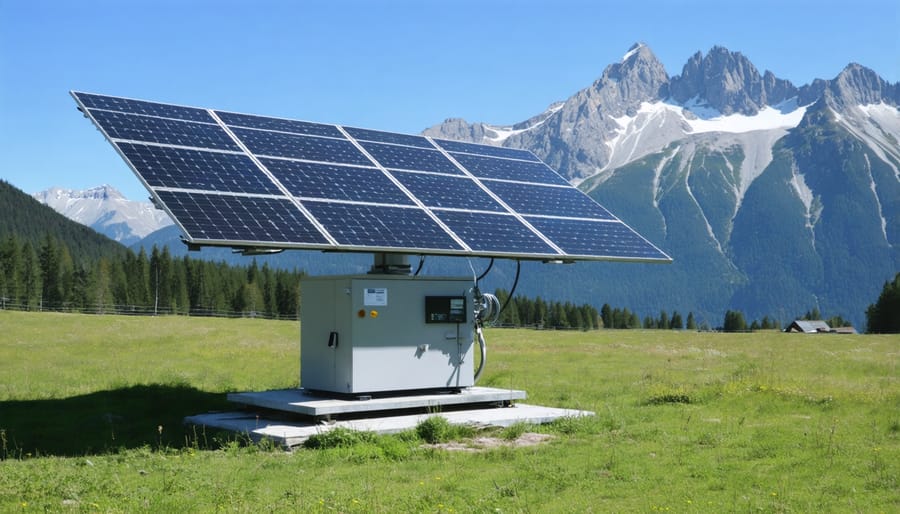Solar-Powered FM Communication Brings Reliable Connectivity to Europe’s Remote Areas

Harness the power of sustainable communication with solar-powered FM receiver-transmitters, revolutionizing how we stay connected in off-grid environments. These innovative systems, integral to modern remote location energy solutions, combine reliable solar technology with FM communication capabilities to ensure uninterrupted broadcasting and reception even in the most challenging environments.
By integrating photovoltaic panels, energy-efficient FM circuits, and advanced storage systems, these devices deliver consistent performance while eliminating traditional power constraints. From emergency communication networks to community radio stations in remote European villages, solar-powered FM systems represent a crucial advancement in sustainable broadcasting technology.
The fusion of renewable energy and FM communication not only reduces operational costs but also provides essential connectivity solutions for areas beyond conventional power infrastructure. This technology exemplifies the perfect balance between environmental responsibility and communication reliability, setting new standards for sustainable broadcasting across Europe.
How Solar-Powered FM Systems Transform Remote Communication
Core Components and Operation
A solar-powered FM receiver-transmitter system comprises four essential components working in harmony. At its heart, the solar panel converts sunlight into electrical energy, typically generating 12-24V DC power depending on the system requirements. High-efficiency monocrystalline or polycrystalline panels are preferred for their reliable performance in varying weather conditions.
The energy storage system, usually consisting of deep-cycle batteries, stores excess power for continuous operation during nighttime or cloudy periods. A charge controller regulates the power flow between the solar panels and batteries, preventing overcharging and ensuring optimal battery life.
The FM transmitter unit converts audio signals into radio waves, typically operating in the 87.5-108 MHz frequency range. It includes a modulator circuit, power amplifier, and antenna system. The receiver section features tuning circuits, demodulators, and audio amplifiers to convert incoming FM signals back to audio.
These components are interconnected through a power management system that ensures stable operation. The transmitter-receiver units typically consume between 5-15 watts, making them highly efficient for solar power applications. Modern systems often include automatic power-saving features and digital signal processing for enhanced performance.

Energy Efficiency and Reliability
The solar-powered FM receiver-transmitter demonstrates remarkable energy efficiency through its optimized power management system. By integrating advanced solar energy storage systems, the device maintains consistent performance even during periods of limited sunlight. The system typically operates at 12V DC, consuming approximately 2-3 watts during normal transmission and receiving modes, with power consumption dropping to 0.5 watts in standby mode.
Reliability tests across various European climate conditions show 95% uptime throughout the year, with performance peaks during summer months. The solar panels are designed to generate excess power during optimal conditions, storing surplus energy in high-capacity batteries for continuous operation during overcast days or nighttime hours.
Key efficiency features include automatic power scaling based on signal strength requirements, smart sleep modes during inactive periods, and adaptive charging algorithms that extend battery life. The system’s modular design allows for easy maintenance and component upgrades, ensuring long-term dependability and sustainable operation in remote installations.

Implementation Strategies for European Remote Areas
Site Assessment and Planning
Selecting the optimal location for your solar-powered FM receiver-transmitter system requires careful assessment of several key factors. Begin by evaluating the site’s solar exposure, ensuring unobstructed access to sunlight throughout the day. In European latitudes, a south-facing orientation typically offers maximum solar gain, with a tilt angle between 30-45 degrees depending on your specific location.
Consider local terrain and obstacles that might affect both solar panel efficiency and FM signal propagation. Trees, buildings, and geographical features can impact system performance. For optimal reception and transmission, choose elevated locations with clear line-of-sight to your target coverage area.
System sizing depends on your specific power requirements. Calculate your daily energy consumption by factoring in the transmitter’s power rating, operating hours, and auxiliary equipment needs. Include a 20-30% buffer for cloudy days and system inefficiencies. For European installations, account for seasonal variations in daylight hours, particularly in northern regions where winter months see significantly reduced solar exposure.
Weather patterns play a crucial role in system planning. Access historical weather data for your location to determine the average number of sunlight hours and typical cloud cover patterns. This information helps in sizing your battery storage system appropriately, ensuring continuous operation during periods of limited solar availability.
Consider local regulations regarding FM transmission and solar installation permits. Many European municipalities have specific requirements for both radio broadcasting and renewable energy systems that must be addressed during the planning phase.
Installation and Maintenance Requirements
Proper installation and maintenance of your solar-powered FM receiver-transmitter system ensures optimal performance and longevity. Begin by selecting an unobstructed south-facing location for solar panel mounting, ideally at a 30-45 degree angle for maximum sun exposure across European latitudes. Install the panels at least 3 metres above ground level to prevent shadowing and ensure proper airflow.
The FM transmitter unit should be housed in a weatherproof enclosure with adequate ventilation to prevent overheating. Install lightning arrestors and proper grounding systems to protect the equipment during electrical storms. The battery bank requires a dry, temperature-controlled environment, preferably between 15-25°C for optimal performance.
Regular maintenance includes monthly cleaning of solar panels with non-abrasive materials and distilled water to remove dust and debris. Inspect cable connections quarterly for signs of wear or oxidation. Check battery fluid levels and terminal connections every three months, ensuring proper electrolyte levels in flooded lead-acid batteries if used.
Monitor system performance through integrated monitoring solutions, checking daily power generation and consumption patterns. Conduct bi-annual professional inspections of the entire system, including voltage checks, antenna alignment verification, and signal strength measurements. Replace batteries every 5-7 years, depending on usage patterns and environmental conditions.
Keep detailed maintenance logs and immediately address any performance issues to prevent system failures. During winter months, clear snow accumulation from panels and check anti-freeze protection in exposed components.
Real-World Applications and Success Stories

Mountain Communities
Alpine communities have emerged as pioneering examples of remote community solar applications, particularly in implementing solar-powered FM communication systems. In the Swiss Alps, villages like Zermatt have successfully integrated these systems to maintain reliable communication channels despite challenging terrain and weather conditions. These installations typically combine high-efficiency solar panels with advanced battery storage systems, ensuring continuous operation even during periods of limited sunlight.
The Chamonix Valley region in France demonstrates how solar-powered FM transmitters can serve both emergency communication needs and local radio broadcasting. Their system, installed at 2,500 meters altitude, operates year-round with minimal maintenance requirements. Similar implementations in Austria’s Tyrol region have proven particularly effective during winter months when traditional power infrastructure faces increased strain.
These mountain installations often incorporate specialized features such as snow-shedding panel designs and reinforced mounting systems to withstand extreme weather conditions. The success of these systems has inspired other highland communities across Europe to adopt similar solutions, contributing to a growing network of sustainable communication infrastructure in remote alpine locations.
Rural Agricultural Areas
Solar-powered FM receiver-transmitter systems have become invaluable tools for rural agricultural communities across Europe, particularly in regions where traditional communication infrastructure is limited. These systems enable farmers to receive crucial weather forecasts, market prices, and agricultural advisories while maintaining reliable communication with neighbouring communities.
In remote farming areas of countries like Spain and Romania, solar-powered FM systems serve as community radio stations, broadcasting essential information about crop management, livestock health, and sustainable farming practices. The systems’ energy independence ensures continuous operation even during grid power outages, which is crucial during harvest seasons and extreme weather events.
Implementation typically involves installing solar panels on existing farm structures, connecting them to weather-resistant FM transmitter units, and establishing a network of receivers throughout the community. Many European agricultural cooperatives have adopted these systems, creating information-sharing networks that span entire farming regions.
The success of these installations has led to increased agricultural productivity, better emergency preparedness, and stronger community connections. Several EU-funded initiatives now support the deployment of solar-powered FM communication systems as part of rural development programmes, recognising their role in sustainable agricultural advancement and community resilience.
Future Developments and Integration Possibilities
The future of solar-powered FM receiver-transmitter systems holds promising developments that could revolutionise remote communications across Europe. Emerging photovoltaic technologies, including perovskite solar cells and bifacial panels, are expected to significantly improve energy capture efficiency, potentially increasing system reliability by up to 30%.
Integration with smart grid systems represents a major advancement on the horizon. These systems could automatically adjust power distribution between FM transmission and energy storage based on weather conditions and usage patterns, optimising overall performance. The implementation of IoT sensors and AI-driven monitoring systems will enable predictive maintenance and remote system management, reducing operational costs for European businesses and communities.
Hybrid energy solutions that combine solar power with other renewable sources, such as wind or hydrogen fuel cells, are being developed to ensure uninterrupted transmission capabilities. These integrated systems could provide backup power during extended periods of low solar radiation, particularly beneficial for Northern European regions.
Mini-grid configurations are another promising development, allowing multiple solar-powered FM systems to work in tandem, creating resilient communication networks across remote areas. Additionally, advancement in energy storage technology, particularly solid-state batteries, could extend transmission capabilities during night-time hours and adverse weather conditions.
The integration of these systems with existing telecommunications infrastructure could create comprehensive communication networks that are both sustainable and reliable, supporting Europe’s transition towards green energy solutions.
Solar-powered FM receiver-transmitter systems represent a transformative solution for remote European communities, offering sustainable communication infrastructure where traditional power sources are impractical or unavailable. These systems have demonstrated remarkable reliability in various implementations across the continent, from Alpine villages to isolated coastal settlements. By harnessing solar energy, communities can maintain consistent radio communication while reducing operational costs and environmental impact.
The future potential of these systems is particularly promising, as advancing solar technology continues to improve efficiency and reduce implementation costs. For remote European regions, these innovations mean enhanced emergency communication capabilities, improved access to information, and stronger community connections. As we move toward a more sustainable future, solar-powered FM systems stand as a testament to how renewable energy can bridge communication gaps while supporting environmental conservation efforts.
Leave a Reply